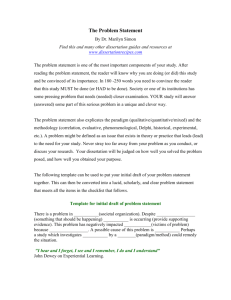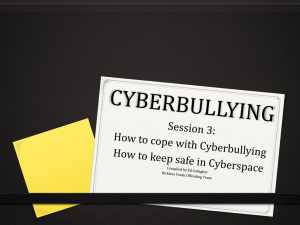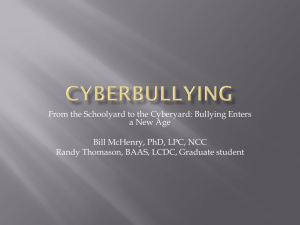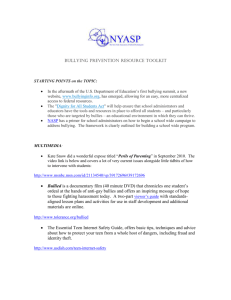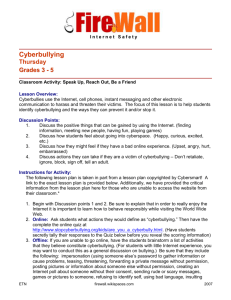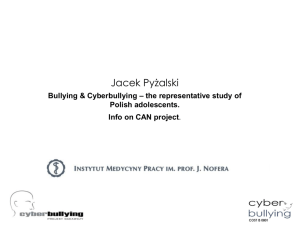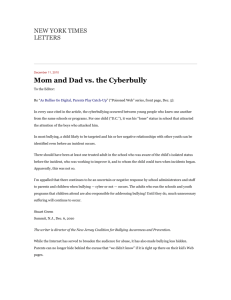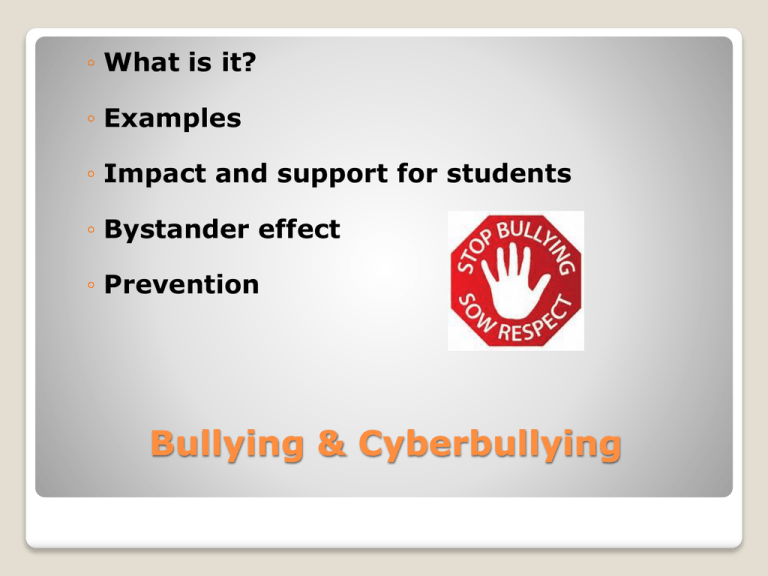
◦ What is it?
◦ Examples
◦ Impact and support for students
◦ Bystander effect
◦ Prevention
Bullying & Cyberbullying
“Bullying is the intention to repeatedly
harm someone over time. It occurs in a
relationship where an imbalance of power
exists. It includes unwelcome physical
contact, verbal and /or emotional abuse
with the intent to harm, embarrass, or
demean another person.”
Bullying
Physical Acts
-Unwanted touching, hitting, tripping, making
someone drop books, stealing or damaging items
Verbal Abuse
-Teasing
-Name-calling, put-downs
-Harmful gossip, threats
Emotional Abuse
-Intimidation
-Humiliation
-Exclusion or Social Isolation
Cyber
-Texting, internet, facebook, twitter, instagram, blogs
Examples of Bullying
By Students:
• Report all instances of bullying to your
parent, teacher, and/or administrator
• Walk away and refrain from fighting
• Walk with a group of students
• Don’t confront the bully head-on
• Don’t carry a weapon
• Ask for help from adults to learn how to
improve social skills
Helping
“An aggressive, intentional act carried
out by a group or individual, using
electronic forms of contact,
repeatedly and over time against a
victim who cannot easily defend him
or herself.”
Smith et al., 2008
Cyberbullying
Repeatedly sending offensive, rude and insulting
messages
• Distributing or posting derogatory information
about another
• Posting or sending digitally altering photos
• Impersonating another and sending offensive
messages
• Tricking someone into revealing embarrassing
information and forwarding to others
• Teasing
• Spreading rumors
• Defamation
•
Examples of Cyberbullying
Bullying
A bully says something nasty
and its only heard when
he/she says it.
The bully makes him/herself
known to the victim.
The primary bully is usually
physically stronger.
Bullies are usually limited to
attacking at certain hours of
the day.
Often bullies attack face-toface.
In most physical bullying
attacks, there are relatively
few witnesses.
Cyberbullying
A cyberbully can say
something damaging online
and it may be accessed
practically forever.
Often times the bully can be
anonymous.
Physical stature of the bully
is not relevant.
Cyberbullying can be done
24/7.
Cyberbullying is never faceto-face.
Witnesses of cyberbullying
can be within the school,
country or even world-wide.
Bullying
Reasons for
Cyberbuylling
•Retaliation
Entertainment
Gain social status
• Assertion
• Jealousy
• Boredom
• Peer pressure
• Anonymity
•
•
By Bystanders:
• Choose not to be a part of the problem
• Help the target get away or distract them
• Comfort the victim of cyberbullying/sexting
• Don’t contribute to a blog or web poll that attacks a
target
• Don’t forward or copy and paste harmful, hurtful or
derogatory emails, text messages or pictures to another
site.
• Save, copy and print out examples of cyberbullying and
give them to the target so he/she can be aware of what
is happening and report to an adult.
• Tell a caring adult you trust who will keep your identity
Other Ways of Helping
•
•
•
•
•
•
•
•
•
•
•
•
By Parents:
Stress respect in your home by modeling positive regard for
everyone
Teach & model appropriate interpersonal skills
Teach your child to seek help from a trusted adult
Explain bullying and why it is wrong
Hold regular family meetings for discussion of issues
Talk to your child
Listen, Listen, and Listen to your child
Discuss and role play positive strategies to use
Encourage your child to stay with a group
Record details-who, when, where, and what happened
Request a conference with the teacher, counselor, & principal
Monitor your child’s friends
Helping


